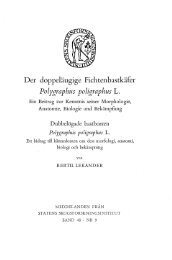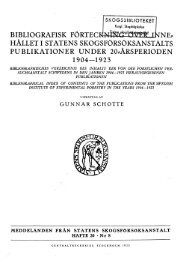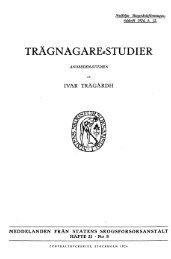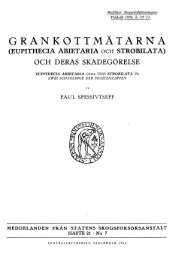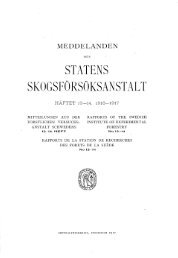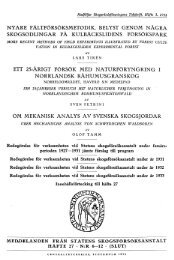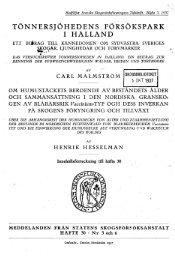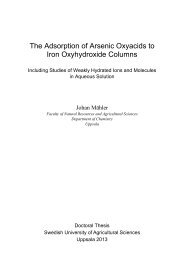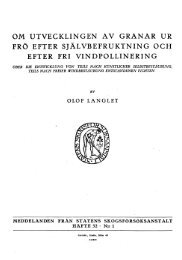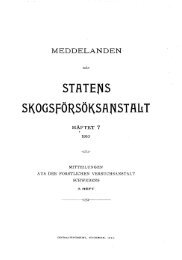SVERIGES LANTBRUKSUNIVERSITET - Epsilon Open Archive - SLU
SVERIGES LANTBRUKSUNIVERSITET - Epsilon Open Archive - SLU
SVERIGES LANTBRUKSUNIVERSITET - Epsilon Open Archive - SLU
You also want an ePaper? Increase the reach of your titles
YUMPU automatically turns print PDFs into web optimized ePapers that Google loves.
68<br />
gradients, respectively, above the surface within a distance of the<br />
order of l m. This approach, here called the Bowen ratio (BR) method,<br />
has of ten been used for reference because it is physically sound and<br />
the calculation doesn't include empirical factors. One must, however,<br />
be aware of the assumption of equality of heat and water vapour<br />
transfer coefficients when interpreting the data obtained by the BR<br />
method (Tanner, 1960). The difficulty in accurately measuring the<br />
temperature and water vapour gradients limits the use of this method<br />
for research purposes mainly.<br />
3. Experiments<br />
Experiments were carried at two sites, an energy peat production<br />
area at Höystösensuo (61°55'N, 26°07'E) during years 1988 and 1989 and<br />
an oats field at Jokioinen Observatory (60°49', 23°30') during 1989.<br />
Nearly continuous data recordings we re obtained over the summer months<br />
in 1989.<br />
To measure skin surface temperature we used IR-thermometers with<br />
two viewing angles, 15° and 60°. Emissivity was assumed to be<br />
constant at 0.98 for the vegetation covered and the bare ground.<br />
Deviations from this value during the different phases of crop<br />
development were expected to be small. For a parti al crop cover (oats<br />
crop at an early vegetative phase) we further assumed that the IR<br />
thermometer will see plants and bare soil approximatively in the same<br />
proportion as the two surfaces contribute to the gross<br />
evapotranspiration. For a complete green canopy the surface seen by<br />
the thermometer, placed a few meters height above ground, will depend<br />
on the zenith angle. It was assumed that pointing the thermometer at<br />
an 45° angle would give a representative estimate of the evaporating<br />
top leaf layer. No significant dependence on the azimuth angle of the<br />
IR-thermometer was detected.<br />
Net radiation was measured with a rigid dome net radiometer.<br />
Approximative values of Rn may also be obtained, for instance, by<br />
measuring short wave global radiation and reflected radiation with<br />
pyranometers and applying empirical correction factors. Pyranometers<br />
suit better for unattended remote sites.





